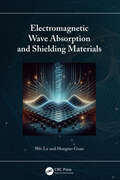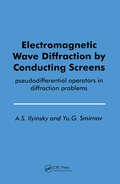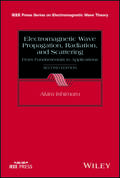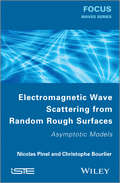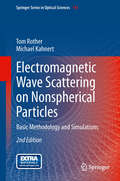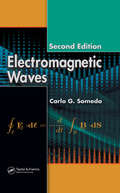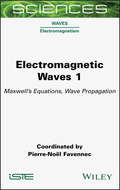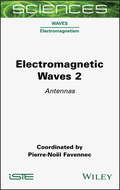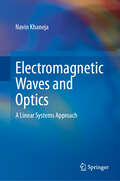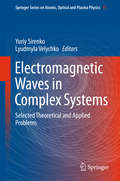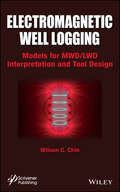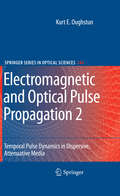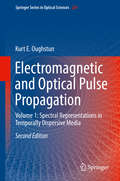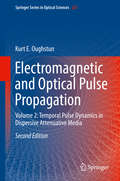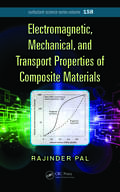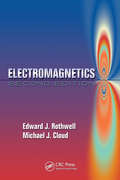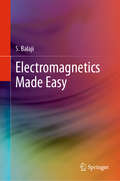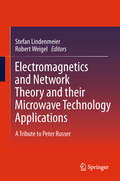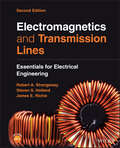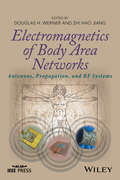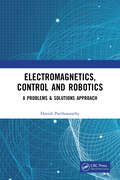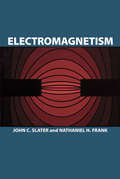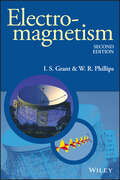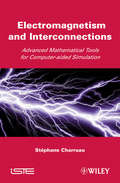- Table View
- List View
Electromagnetic Wave Absorbers: Detailed Theories and Applications
by Youji KotsukaAddresses the importance of EM wave absorbers and details pertinent theory, design, and applications Demands for various EM-wave absorbers are rapidly increasing along with recent trends toward complicated electromagnetic environments and development of higher-frequency communication equipment, including AI technology. This book provides a broad perspective on electromagnetic wave absorbers, as well as discussion of specific types of absorbers, their advantages and disadvantages, their applications, and performance verification. Electromagnetic Wave Absorbers: Detailed Theories and Applications presents the theory behind wave absorbers and their practical usage in design of EM-wave absorber necessary particularly for EMC environments, and similar applications. The first half of the book contains the foundations of electromagnetic wave engineering, specifically the transmission line theories necessary for EM-wave absorber analysis, the basic knowledge of reflection, transmission, and absorption of electromagnetic waves, derivation of Maxwell's equations and computer analysis. The second half describes special mediums, absorber application examples, simplified methods of absorber design, autonomously controllable EM-wave absorber, and more. This valuable text: Provides detailed explanations of basic theory and applied theory for understanding EM-wave absorbers Discusses the material constant measurement methods of EM-wave absorption characteristics that are necessary for designing EM-wave absorbers Includes examples of novel EM-wave absorber configurations Electromagnetic Wave Absorbers: Detailed Theories and Applications is an ideal read for researchers and students concerned with electromagnetic wave engineering. It will also appeal to computer software engineers and electromagnetic field theory researchers.
Electromagnetic Wave Absorption and Shielding Materials
by Wei Lu Hongtao GuanThis book reveals the latest research findings and innovations in electromagnetic wave absorption and shielding by exploring the design and application of absorbent materials, the optimization of shielding structures and the improvement of testing and evaluation methods.From conductive materials to magnetic materials, and composite materials to nanomaterials, Electromagnetic Wave Absorption and Shielding Materials details the characteristics and advantages of various absorbent materials and explains their applications in electromagnetic wave absorption and shielding. It then introduces the different methods of electromagnetic shielding, including structural shielding and material shielding. The book also studies experimental and testing techniques, including measurement methods and evaluation criteria for electromagnetic wave absorption performance.The book will be of interest to researchers and graduate students in electromagnetic compatibility, materials science and engineering.
Electromagnetic Wave Diffraction by Conducting Screens pseudodifferential operators in diffraction problems
by Yu. G. SmirnovThis book covers the latest problems of modern mathematical methods for three-dimensional problems of diffraction by arbitrary conducting screens. This comprehensive study provides an introduction to methods of constructing generalized solutions, elements of potential theory, and other underlying mathematical tools. The problem settings, which turn out to be extremely effective, differ significantly from the known approaches and are based on the original concept of vector spaces 'produced' by Maxwell equations. The formalism of pseudodifferential operators enables to prove uniqueness theorems and the Fredholm property for all problems studied. Readers will gain essential insight into the state-of-the-art technique of investigating three-dimensional problems for closed and unclosed screens based on systems of pseudodifferential equations. A detailed treatment of the properties of their kernels, in particular degenerated, is included. Special attention is given to the study of smoothness of generalized solutions and properties of traces.
Electromagnetic Wave Propagation, Radiation, and Scattering: From Fundamentals to Applications (Second Edition)
by Akira IshimaruPresented in two parts, this book takes an analytical approach on the subject and emphasizes new ideas and applications used today. Part one covers fundamentals of electromagnetic wave propagation, radiation, and scattering. It provides ample end-of-chapter problems and offers a 90-page solution manual to help readers check and comprehend their work. The second part of the book explores up-to-date applications of electromagnetic waves—including radiometry, geophysical remote sensing and imaging, and biomedical and signal processing applications. Written by a world renowned authority in the field of electromagnetic research, this new edition of Electromagnetic Wave Propagation, Radiation, and Scattering: From Fundamentals to Applications presents detailed applications with useful appendices, including mathematical formulas, Airy function, Abel’s equation, Hilbert transform, and Riemann surfaces. Primarily a textbook for graduate courses in electrical engineering, Electromagnetic Wave Propagation, Radiation, and Scattering is also ideal for graduate students in bioengineering, geophysics, ocean engineering, and geophysical remote sensing. The book is also a useful reference for engineers and scientists working in fields such as geophysical remote sensing, bio–medical engineering in optics and ultrasound, and new materials and integration with signal processing.
Electromagnetic Wave Scattering from Random Rough Surfaces: Asymptotic Models
by Christophe Boulier Nicolas PinelElectromagnetic wave scattering from random rough surfaces is an active, interdisciplinary area of research with myriad practical applications in fields such as optics, acoustics, geoscience and remote sensing. Focusing on the case of random rough surfaces, this book presents classical asymptotic models used to describe electromagnetic wave scattering. The authors begin by outlining the basic concepts relevant to the topic before moving on to look at the derivation of the scattered field under asymptotic models, based on the Kirchhoff-tangent plane, in order to calculate both the scattered field and the statistical average intensity. More elaborated asymptotic models are also described for dealing with specific cases, and numerical results are presented to illustrate these models. Comparisons with a reference numerical method are made to confirm and refine the theoretical validity domains. The final chapter derives the expressions of the scattering intensities of random rough surfaces under the asymptotic models. Its expressions are given for their incoherent contributions, from statistical calculations. These results are then compared with numerical computations using a Monte-Carlo process, as well as with experimental models, for sea surface backscattering. Contents 1. Electromagnetic Wave Scattering from Random Rough Surfaces: Basics. 2. Derivation of the Scattered Field under Asymptotic Models. 3. Derivation of the Normalized Radar Cross-Section under Asymptotic Models. APPENDIX 1. Far-Field Scattered Fields under the Method of Stationary Phase. APPENDIX 2. Calculation of the Scattering Coefficients under the GO for 3D Problems. About the Authors Nicolas Pinel worked as a Research Engineer at the IETR (Institut d’Electronique et de Télécommunications de Rennes) laboratory at Polytech Nantes (University of Nantes, France) before joining Alyotech Technologies in Rennes, France, in July 2013. His research interests are in the areas of radar and optical remote sensing, scattering and propagation. In particular, he works on asymptotic methods of electromagnetic wave scattering from random rough surfaces and layers. Christophe Bourlier works at the IETR (Institut d’Electronique et de Télécommunications de Rennes) laboratory at Polytech Nantes (University of Nantes, France) and is also a Researcher at the French National Center for Scientific Research (CNRS) on electromagnetic wave scattering from rough surfaces and objects for remote sensing applications and radar signatures. He is the author of more than 160 journal articles and conference papers.
Electromagnetic Wave Scattering on Nonspherical Particles
by Tom Rother Michael KahnertThis book gives a detailed overview of the theory of electromagnetic wave scattering on single, homogeneous, but nonspherical particles. Beside the systematically developed Green's function formalism of the first edition this second and enlarged edition contains additional material regarding group theoretical considerations for nonspherical particles with boundary symmetries, an iterative T-matrix scheme for approximate solutions, and two additional but basic applications. Moreover, to demonstrate the advantages of the group theoretical approach and the iterative solution technique, the restriction to axisymmetric scatterers of the first edition was abandoned.
Electromagnetic Waves (Second Edition)
by Carlo G. SomedaAdapted from a successful and thoroughly field-tested Italian text, the first edition of Electromagnetic Waves was very well received. Its broad, integrated coverage of electromagnetic waves and their applications forms the cornerstone on which the author based this second edition. <P><P>Working from Maxwell's equations to applications in optical communications and photonics, Electromagnetic Waves, Second Edition forges a link between basic physics and real-life problems in wave propagation and radiation. <P><P>Accomplished researcher and educator Carlo G. Someda uses a modern approach to the subject. Unlike other books in the field, it surveys all major areas of electromagnetic waves in a single treatment. <P><P>The book begins with a detailed treatment of the mathematics of Maxwell's equations. It follows with a discussion of polarization, delves into propagation in various media, devotes four chapters to guided propagation, links the concepts to practical applications, and concludes with radiation, diffraction, coherence, and radiation statistics. <P><P>This edition features many new and reworked problems, updated references and suggestions for further reading, a completely revised appendix on Bessel functions, and new definitions such as antenna effective height. <P><P>Illustrating the concepts with examples in every chapter, Electromagnetic Waves, Second Edition is an ideal introduction for those new to the field as well as a convenient reference for seasoned professionals.
Electromagnetic Waves 1: Maxwell's Equations, Wave Propagation
by Pierre-Noël FavennecElectromagnetic Waves 1 examines Maxwell’s equations and wave propagation. It presents the scientific bases necessary for any application using electromagnetic fields, and analyzes Maxwell’s equations, their meaning and their resolution for various situations and material environments. These equations are essential for understanding electromagnetism and its derived fields, such as radioelectricity, photonics, geolocation, measurement, telecommunications, medical imaging and radio astronomy. This book also deals with the propagation of electromagnetic, radio and optical waves, and analyzes the complex factors that must be taken into account in order to understand the problems of propagation in a free and confined space. Electromagnetic Waves 1 is a collaborative work, completed only with the invaluable contributions of Ibrahima Sakho, Hervé Sizun and JeanPierre Blot, not to mention the editor, Pierre-Noël Favennec. Aimed at students and engineers, this book provides essential theoretical support for the design and deployment of wireless radio and optical communication systems.
Electromagnetic Waves 2: Antennas
by Pierre-Noël FavennecElectromagnetic Waves 2 examines antennas in the field of radio waves. It analyzes the conditions of use and the parameters that are necessary in order to create an effective antenna. This book presents antennas’ definitions, regulations and fundamental equations, and describes the various forms of antennas that can be used in radio: horns, waveguides, coaxial cables, printed and miniature antennas. It presents the characterization methods and the link budgets as well as the digital methods that make the fine calculation of radio antennas possible. Electromagnetic Waves 2 is a collaborative work, completed only with the invaluable contributions of Ibrahima Sakho, Hervé Sizun and JeanPierre Blot, not to mention the editor, Pierre-Noël Favennec. Aimed at students and engineers, this book provides essential theoretical support for the design and deployment of wireless radio and optical communication systems.
Electromagnetic Waves and Optics: A Linear Systems Approach
by Navin KhanejaThe book explores electromagnetic (EM) waves, which are present everywhere—from radio, television, and cell phones to satellite dishes, antennas, and WiFi. The propagation of EM waves is governed by Maxwell's equations. When these waves pass through a medium, they slow down and refract, while in a metallic medium, they are reflected. Metallic boxes and pipes can store and direct EM waves, known as cavities and waveguides. Oscillating currents generate and transmit EM waves through antennas, allowing for long-distance communication after the waves propagate. Since oscillating currents emit EM waves, the author uses coaxial cables and transmission lines to reduce radiation and carry high-frequency currents efficiently. EM waves at very high frequencies in the optical range are responsible for transmitting visual information. The author also discusses lenses and optical instruments like telescopes and microscopes, which are used to magnify optical signals. Additionally, the quantum mechanical origins of a material’s permittivity, which affects the speed of light through the medium, are examined.
Electromagnetic Waves in Complex Systems
by Yuriy Sirenko Lyudmyla VelychkoThis book gives guidance to solve problems in electromagnetics, providing both examples of solving serious research problems as well as the original results to encourage further investigations. The book contains seven chapters on various aspects of resonant wave scattering, each solving one original problem. All of them are unified by the authors' desire to show advantages of rigorous approaches at all stages, from the formulation of a problem and the selection of a method to the interpretation of results. The book reveals a range of problems associated with wave propagation and scattering in natural and artificial environments or with the design of antennas elements. The authors invoke both theoretical (analytical and numerical) and experimental techniques for handling the problems. Attention is given to mathematical simulations, computational efficiency, and physical interpretation of the experimental results. The book is written for students, graduate students and young researchers.
Electromagnetic Well Logging
by Wilson C. ChinAlmost all publications on borehole electromagnetics deal with idealizations that are not acceptable physically, and unfortunately, even these models are company proprietary. On the other hand, "exact models" are only available through detailed finite element or finite difference analysis, and more often than not, simply describe case studies for special applications. In either case, the models are not available for general use and the value of the publications is questionable. This new approach provides a rigorous, fully three-dimensional solution to the general problem, developed over almost two decades by a researcher familiar with practical applications and mathematical modeling. Completely validated against exact solutions and physics-based checks through over a hundred documented examples, the self-contained model (with special built-in matrix solvers and iteration algorithms) with a "plain English graphical user interface" has been optimized to run extremely fast - seconds per run as opposed to minutes and hours - and then automatically presents all electric and magnetic field results through integrated three-dimensional color graphics. In addition to state-of-the-art algorithms, basic "utility programs" are also developed, such as simple dipole methods, Biot-Savart large diameter models, nonlinear phase and amplitude interpolation algorithms, and so on. Incredibly useful to oilfield practitioners, this volume is a must-have for serious professionals in the field, and all the algorithms have undergone a laborious validation process with real use in the field.
Electromagnetic and Optical Pulse Propagation 2
by Kurt E. OughstunElectromagnetic & Optical Pulse Propagation presents a detailed, systematic treatment of the time-domain electromagnetics with application to the propagation of transient electromagnetic fields (including ultrawideband signals and ultrashort pulses) in homogeneous, isotropic media which exhibit both temporal frequency dispersion and attenuation. The development is mathematically rigorous with strict adherence to the fundamental physical principle of causality. Approximation methods are based upon mathematically well-defined asymptotic techniques that are based upon the saddle point method. A detailed description is given of the asymptotic expansions used. Meaningful exercises are given throughout the text to help the reader's understanding of the material, making the book a useful graduate level text in electromagnetic wave theory for both physics, electrical engineering and materials science programs. Both students and researchers alike will obtain a better understanding of time domain electromagnetics as it applies to electromagnetic radiation and wave propagation theory with applications to ground and foliage penetrating radar, medical imaging, communications, and the health and safety issues associated with ultrawideband pulsed fields. Volume 2 presents a detailed asymptotic description of plane wave pulse propagation in dielectric, conducting, and semiconducting materials as described by the classical Lorentz model of dielectric resonance, the Rocard-Powles-Debys model of orientational polarization, and the Drude model of metals. The rigorous description of the signal velocity of a pulse in a dispersive material is presented in connection with the question of superluminal pulse propagation.
Electromagnetic and Optical Pulse Propagation: Volume 1: Spectral Representations in Temporally Dispersive Media (Springer Series in Optical Sciences #224)
by Kurt E. OughstunThis volume presents a detailed, rigorous treatment of the fundamental theory of electromagnetic pulse propagation in causally dispersive media that is applicable to dielectric, conducting, and semiconducting media. Asymptotic methods of approximation based upon saddle point methods are presented in detail.
Electromagnetic and Optical Pulse Propagation: Volume 2: Temporal Pulse Dynamics in Dispersive Attenuative Media (Springer Series in Optical Sciences #225)
by Kurt E. OughstunIn two volumes, this book presents a detailed, systematic treatment of electromagnetics with application to the propagation of transient electromagnetic fields (including ultrawideband signals and ultrashort pulses) in dispersive attenuative media. The development in this expanded, updated, and reorganized new edition is mathematically rigorous, progressing from classical theory to the asymptotic description of pulsed wave fields in Debye and Lorentz model dielectrics, Drude model conductors, and composite model semiconductors. It will be of use to researchers as a resource on electromagnetic radiation and wave propagation theory with applications to ground and foliage penetrating radar, medical imaging, communications, and safety issues associated with ultrawideband pulsed fields. With meaningful exercises, and an authoritative selection of topics, it can also be used as a textbook to prepare graduate students for research. Volume 2 presents a detailed asymptotic description of plane wave pulse propagation in dielectric, conducting, and semiconducting materials as described by the classical Lorentz model of dielectric resonance, the Rocard-Powles-Debye model of orientational polarization, and the Drude model of metals. The rigorous description of the signal velocity of a pulse in a dispersive material is presented in connection with the question of superluminal pulse propagation. The second edition contains new material on the effects of spatial dispersion on precursor formation, and pulse transmission into a dispersive half space and into multilayered media. Volume 1 covers spectral representations in temporally dispersive media.
Electromagnetic, Mechanical, and Transport Properties of Composite Materials (Surfactant Science)
by Rajinder PalIn the design, processing, and applications of composite materials, a thorough understanding of the physical properties is required. It is important to be able to predict the variations of these properties with the kind, shape, and concentration of filler materials. The currently available books on composite materials often emphasize mechanical pro
Electromagnetics (Electrical Engineering Textbook Ser.)
by Michael J. Cloud Edward J. Rothwell<p>Providing an ideal transition from introductory to advanced concepts, Electromagnetics, Second Edition builds a foundation that allows electrical engineers to confidently proceed with the development of advanced EM studies, research, and applications. <p>This second edition of a popular text continues to offer coverage that spans the entire field, from electrostatics to the integral solutions of Maxwell’s equations. The book provides a firm grounding in the fundamental concepts of electromagnetics and bolsters understanding through the use of classic examples in shielding, transmission lines, waveguides, propagation through various media, radiation, antennas, and scattering. Mathematical appendices present helpful background information in the areas of Fourier transforms, dyadics, and boundary value problems. The second edition adds a new and extensive chapter on integral equation methods with applications to guided waves, antennas, and scattering. <p>Utilizing the engaging style that made the first edition so appealing, this second edition continues to emphasize the most enduring and research-critical electromagnetic principles.</p>
Electromagnetics Made Easy
by S. BalajiThis book is intended to serve as an undergraduate textbook for a beginner’s course in engineering electromagnetics. The present book provides an easy and simplified understanding of the basic principles of electromagnetics. Abstract theory has been explained using real life examples making it easier for the reader to grasp the complicated concepts. An introductory chapter on vector calculus and the different coordinate systems equips the readers with the prerequisite knowledge to learn electromagnetics. The subsequent chapters can be grouped into four broad sections – electrostatics, magnetostatics, time varying fields, and applications of electromagnetics. Written in lucid terms, the text follows a sequential presentation of the topics, and discusses the relative merits and demerits of each method. Each chapter includes a number of examples which are solved rigorously along with pictorial representations. The book also contains about 400 figures and illustrations which help students visualize the underlying physical concepts. Several end-of-chapter problems are provided to test the key concepts and their applications. Thus the book offers a valuable resource for both students and instructors of electrical, electronics and communications engineering, and can also be useful as a supplementary text for undergraduate physics students.
Electromagnetics and Network Theory and their Microwave Technology Applications
by Robert Weigel Stefan LindenmeierThis volume provides a discussion of the challenges and perspectives of electromagnetics and network theory and their microwave applications in all aspects. It collects the most interesting contribution of the symposium dedicated to Professor Peter Russer held in October 2009 in Munich.
Electromagnetics and Transmission Lines: Essentials for Electrical Engineering
by Steven Sean Holland Robert Alan Strangeway James Elwood RichieElectromagnetics and Transmission Lines Textbook resource covering static electric and magnetic fields, dynamic electromagnetic fields, transmission lines, antennas, and signal integrity within a single course Electromagnetics and Transmission Lines provides coverage of what every electrical engineer (not just the electromagnetic specialist) should know about electromagnetic fields and transmission lines. This work examines several fundamental electrical engineering concepts and components from an electromagnetic fields viewpoint, such as electric circuit laws, resistance, capacitance, and self and mutual inductances. The approach to transmission lines (T-lines), Smith charts, and scattering parameters establishes the underlying concepts of vector network analyzer (VNA) measurements. System-level antenna parameters, basic wireless links, and signal integrity are examined in the final chapters. As an efficient learning resource, electromagnetics and transmission lines content is strategically modulated in breadth and depth towards a single semester objective. Extraneous, distracting topics are excluded. The wording style is somewhat more conversational than most electromagnetics textbooks in order to enhance student engagement and inclusivity while conveying the rigor that is essential for engineering student development. To aid in information retention, the authors also provide supplementary material, including a homework solutions manual, lecture notes, and VNA experiments. Sample topics covered in Electromagnetics and Transmission Lines include: Vector algebra and coordinate systems, Coulomb’s law, Biot-Savart law, Gauss’s law, and solenoidal magnetic flux Electric potential, Ampere’s circuital law, Faraday’s law, displacement current, and the electromagnetic principles underlying resistance, capacitance, and self and mutual inductances The integral form of Maxwell’s equations from a conceptual viewpoint that relates the equations to physical understanding (the differential forms are also included in an appendix) DC transients and AC steady-state waves, reflections, and standing waves on T-lines Interrelationships of AC steady-state T-line theory, the Smith chart, and scattering parameters Antenna basics and line-of-sight link analysis using the Friis equation An introduction to signal integrity Electromagnetics and Transmission Lines is an authoritative textbook learning resource, suited perfectly for engineering programs at colleges and universities with a single required electromagnetic fields course. Student background assumptions are multivariable calculus, DC and AC electric circuits, physics of electromagnetics, and elementary differential equations.
Electromagnetics of Body Area Networks: Antennas, Propagation, and RF Systems
by Zhi Hao Jiang Douglas H. WernerThe book is a comprehensive treatment of the field, covering fundamental theoretical principles and new technological advancements, state-of-the-art device design, and reviewing examples encompassing a wide range of related sub-areas. In particular, the first area focuses on the recent development of novel wearable and implantable antenna concepts and designs including metamaterial-based wearable antennas, microwave circuit integrated wearable filtering antennas, and textile and/or fabric material enabled wearable antennas. The second set of topics covers advanced wireless propagation and the associated statistical models for on-body, in-body, and off-body modes. Other sub-areas such as efficient numerical human body modeling techniques, artificial phantom synthesis and fabrication, as well as low-power RF integrated circuits and related sensor technology are also discussed. These topics have been carefully selected for their transformational impact on the next generation of body-area network systems and beyond.
Electromagnetics, Control and Robotics: A Problems & Solutions Approach
by Harish ParthasarathyThis book covers a variety of problems, and offers solutions to some, in:• Statistical state and parameter estimation in nonlinear stochastic dynamical system in both the classical and quantum scenarios.• Propagation of electromagnetic waves in a plasma as described by the Boltzmann Kinetic Transport Equation.• Classical and Quantum General Relativity. It will be of use to Engineering undergraduate students interested in analysing the motion of robots subject to random perturbation, and also to research scientists working in Quantum Filtering.
Electromagnetism
by John C. Slater Nathaniel H. FrankClearly developed from first principles, this introductory study supplies basic material on electrostatics and magnetostatics, then concentrates on electromagnetic theory -- the authors are both leading men in the field. The book ranges freely over many areas of electromagnetic theory with some concern for electrical engineering. It covers the field theory of electromagnetism, electrostatics and the equations and theorems of Gauss, Poisson, Laplace and Green, solutions of Laplace's equation, dielectrics, magnetic fields of linear and circular currents, electromagnetic induction and Maxwell's equations, electromagnetic waves, electron theory, wave guides and cavity resonators, spherical electromagnetic waves, Huygen's principle and Green's theorem, and Fresnel and Fraunhofer diffraction. Practice problems are supplied at chapter ends.Physicists and engineers will find this presentation particularly useful; but mathematicians have also used the book not only as an introduction to electromagnetism, but also as a means to an increased knowledge of the aims and tools of theoretical physics. The only background required to follow the development is a knowledge of the calculus and differential equations. More advanced mathematics is developed in appendixes.
Electromagnetism (Manchester Physics Series #Vol. 18)
by I. S. Grant W. R. PhillipsThe Manchester Physics Series General Editors: D. J. Sandiford; F.Mandl; A. C. Phillips Department of Physics and Astronomy,University of Manchester Properties of Matter B. H. Flowers and E.Mendoza Optics Second Edition F. G. Smith and J. H. ThomsonStatistical Physics Second Edition F. Mandl Electromagnetism SecondEdition I. S. Grant and W. R. Phillips Statistics R. J. BarlowSolid State Physics Second Edition J. R. Hook and H. E. HallQuantum Mechanics F. Mandl Particle Physics Second Edition B. R.Martin and G. Shaw the Physics of Stars Second Edition A. C.Phillips Computing for Scientists R. J. Barlow and A. R. BarnettElectromagnetism, Second Edition is suitable for a first course inelectromagnetism, whilst also covering many topics frequentlyencountered in later courses. The material has been carefullyarranged and allows for flexi-bility in its use for courses ofdifferent length and structure. A knowledge of calculus and anelementary knowledge of vectors is assumed, but the mathematicalproperties of the differential vector operators are described insufficient detail for an introductory course, and their physicalsignificance in the context of electromagnetism is emphasised. Inthis Second Edition the authors give a fuller treatment of circuitanalysis and include a discussion of the dispersion ofelectromagnetic waves. Electromagnetism, Second Edition features: * The application of the laws of electromagnetism to practicalproblems such as the behaviour of antennas, transmission lines andtransformers. * Sets of problems at the end of each chapter to help studentunderstanding, with hints and solutions to the problems given atthe end of the book. * Optional "starred" sections containing more specialised andadvanced material for the more ambitious reader. * An Appendix with a thorough discussion of electromagneticstandards and units. Recommended by many institutions. Electromagnetism. SecondEdition has also been adopted by the Open University as the coursebook for its third level course on electromagnetism.
Electromagnetism and Interconnections: Advanced Mathematical Tools for Computer-aided Simulation
by Stephane CharruauThis book covers the theoretical problems of modeling electrical behavior of the interconnections encountered in everyday electronic products. The coverage shows the theoretical tools of waveform prediction at work in the design of a complex and high-speed digital electronic system. Scientists, research engineers, and postgraduate students interested in electromagnetism, microwave theory, electrical engineering, or the development of simulation tools software for high speed electronic system design automation will find this book an illuminating resource.

